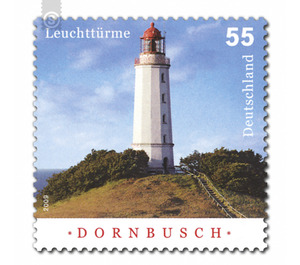Lighthouses - Germany / Federal Republic of Germany 2009 - 55 Euro Cent
Theme: Architecture
| Country | Germany / Federal Republic of Germany |
| Issue Date | 2009 |
| Face Value | 55.00 |
| Stamp Type | Postage stamp |
| Item Type | Stamp |
| Chronological Issue Number | 2616 |
| Chronological Chapter | GER-BRD |
| SID | 130086 |
| In 29 Wishlists | |
In wind and weather, day and night, they have been reliable signposts for shipping on the German coast for over 800 years. From the Jade Bay in the west on the North Sea coast to Usedom on the easternmost section of the German Baltic Sea coast are about 200 beacon buildings. For up to 50 kilometers, the signals of the mighty towers radiate out to sea. But there are also small plants with less charisma and therefore only local significance. Each beacon is recorded on the nautical charts with a specific light signal sequence, which makes it unmistakable and enables orientation in conjunction with other beacons. The special stamp series "Lighthouses" draws attention to the diversity of German lighthouses. The two stamps with the motifs Leuchtturm Norderney and Dornbusch appear on July 2, 2009 in the context of this series. To ensure a year-round steamboat cruise on the Baltic Sea, a network of powerful lighthouses was built at the end of the 19th century. This includes the tower on the partially wooded 70-meter-high Dornbusch mountain range on the island of Hiddensee. The light of the lighthouse Dornbusch radiates from a height of 95 meters above the sea about 46 kilometers out to the sea. From a distance you can see a brief flash of light every ten seconds. The 28 meter high tower was put into operation on 19 November 1888. Since cracks occurred again and again in the outer wall, the building received a solid concrete casing in 1926. In 1929 fine hairline cracks in the surface were closed with a cement lime coating. Since then, the tower has its now twelve-sided shape and a light gray surface. Although the system was switched on and off remotely monitored since the 1970s, the lighthouse keeper remained in service and continued to perform maintenance work on the two-meter-high optics. It was not until 1998 that he ended his activity. Since then, there is no permanent guard on Dornbusch, maintenance is carried out by external experts.


